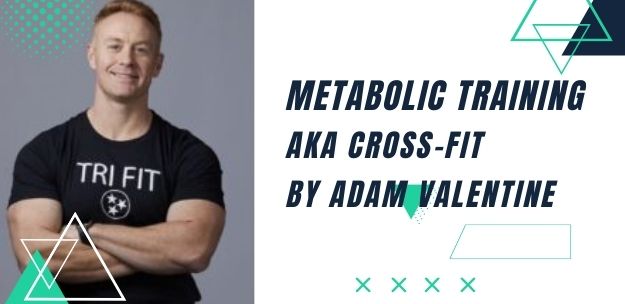
Metabolic Training AKA Cross-fit
Metabolic Training AKA Cross-fit By Adam Valentine “The latest and greatest” The time has come folks, and a new fitness regime has risen. It’s
By Barry Campbell
Sport specific training has changed sports. It has changed the size and ability of the athletes who play those sports and records continue to be broken. Some seem to think steroids are the difference — and that will always be a stigma on the world of sports — but the fact is athletes in all phases are not only training harder, they are training smarter as well. Many athletes train year-round to stay ahead of the curve and produce year-in and year-out; and speed is important to all athletes as it translates into dollars in contracts.

A subculture of sport specific training is speed training. Obviously speed is important to almost any athlete. Speed is the quickness of movement of a limb, whether this is the legs of a running back or the arms of a boxer. Speed is a fundamental part of every sport and can be measured and reproduced as a true indicator of ability. Very often, agility is more relevant to successful sports performance than all-out speed. Agility is the ability to explosively slow down or stop, change direction, and accelerate once again.
Speed can be broken down into three major divisions including all-out speed, agility, and speed endurance. All-out speed is simply the fastest way from point A to point B. It is usually measured in shorter increments, such as 40-yards. Agility, as stated before, is the ability to explosively slow down or stop, change direction, and accelerate once again. This can include lateral movements, vertical movements (jumping), and quick-burst straight line movements. Speed endurance is the ability to replicate the same force over time. Some sports require an endurance level that makes an athlete need more than just quick bursts of energy between rests. Think about the difference between soccer and football. Soccer is almost continuous while football is series of explosive bursts of energy followed by a longer break.
The level of each, all-out speed, agility and speed endurance that an athlete requires is determined by his or her sport. Regardless of the event, there are several modes of training that are fundamental to developing speed. The fundamental elements of speed are flexibility, strength, endurance, and technique. Each of the elements or modalities can be trained separately with the finished product equaling a faster athlete.
Modalities of Speed
Stride Rate/Stride Frequency
Before we talk about the modalities and what they mean to speed, we have to understand what makes us faster to begin with. Speed can be influenced by two different things. Those things are stride length and frequency (strike rate). Stride length refers to the length of the athlete’s stride in full-speed running. Obviously a longer stride length, assuming stride frequency doesn’t change, would allow the athlete to cover more ground, resulting in a faster athlete. The same is true for stride frequency. The faster the strike rate, assuming the stride length doesn’t change, the faster the athlete covers the same area. Some of the modalities influence both strike rate and frequency and others only influence one or the other.
Flexibility
This is very critical in speed as it limits your ability to transfer your gains in other areas such, as strength training. Muscles can only contract as fast as the opposing muscle can relax. Stretching increases the ability for the muscle to relax more quickly. Think of your leg during a sprint. Your quads and hip flexors fire to send the knee up for the stride reaching out in front of you. Once your foot hits the surface, your quads and hip flexors have to relax before the hamstring can engage and pull against the ground — causing the body to be propelled forward. Stretching also allows for a lengthening in stride length due to the leg, knee, and hips improved range of motion.
Strength
Speed and agility are explosive actions and there is no better way to improve an explosive action than to train explosively. This is not your ordinary strength training done with slow controlled repetitions. The training uses many body weight exercises in conjunction with explosive movements. Plyometrics is the term usually associated with theses exercises. Plyometrics train the body to be able to translate strength into power and explosiveness. A squat will build strength in the legs, but a jump squat can transfer that strength into being able to jump higher.
Speed Endurance
The ability of an athlete’s performance not to fall off dramatically after the initial burst of energy is a product of speed endurance training. This type of training is not fun, but it is also the training that can be the difference between winning and losing a game or a starting position on the team. Speed endurance training includes sprinting with recovery, long runs, or drills used as endurance as apposed to technique. It is the ability of your body to eliminate lactic acid from the muscle and recover. When training in succession the body adapts and removes the acid more efficiently. This allows the runner/player to be less effected by the anti athletic effects of lactic acid and being able to produce at a high level for a longer period of time.
Technique
In the speed game every small thing matters. The difference between a 4.4 second 40-yard dash time and a 4.6 is small on paper but big in that break away run in the championship game. That is why everything has to be looked at when improving the runner’s ability. If you have flexibility, endurance, and strength, a good technique can be the difference between making the tackle or crossing the finish line first. Technique can be taught through drills using acceleration and deceleration. The drills need to be short and at full speed due to the technique being trained, not the endurance. This creates the need for longer break times between sets. Posture, dorsiflexion, foot action, and negative foot speed training all improve technique.
Putting it all Together
Now that you have obtained the knowledge of how speed is transferred throughout the process of running and the proper ways to develop the areas that influence that speed, the next thing is to get to work. You could use a four day split with training in the morning and evening. Make sure you complete your speed technique first when at full speed and put endurance workouts after everything if doing them at the same time. A sample workout would look like this:
Sample Program
Monday
Tuesday
Wednesday OFF
Thursday
Friday

Metabolic Training AKA Cross-fit By Adam Valentine “The latest and greatest” The time has come folks, and a new fitness regime has risen. It’s

Caffeine: Bad or Good? It’s the most legal stimulant that’s easy to buy; Caffeine. We all have tried it and seen its remarkable effects. The

The Truth about Lactic Acid By: Adam Valentine Forums all over the map have evolved over the years. Many “theorists” will attempt at proving why
© 2025. All Rights Reserved
Murfreesboro Digital Marketing & Web Design - Boro Business Lab
